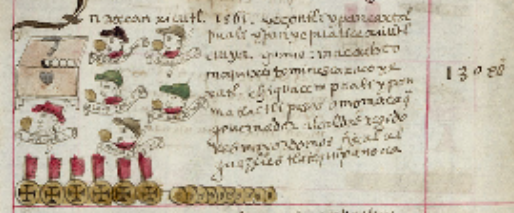cabildo (CST35)
This painting of the town council members of Santa Catalina Texupan is included here as an example of iconography for the term cabildo (Spanish for town council, a term taken into Nahuatl) which does not actually appear here in the companion text. What appears are all the individual titles for the officers of the town council and related occupations. All these terms come from Spanish, but these are jobs held by the local Indigenous nobility. See the dictionary field for the titles and their roles. Each member of this group of heads, which are shown in profile looking toward the viewer’s left, has a banderole with the job title underneath his head. All but two of the titles are in the plural, because multiple men would fill those jobs. The banderole is a European artistic tradition that this Native notary has adopted. It is interesting for the way it combines textual and pictorial writing, as Kevin Terraciano (Codex Sierra, 2021) points out. The men look much alike except for the varying colors of their hats (and the hat of the fiscal is a different shape). They all have red collars, too, except the fiscal. It is somewhat curious that three of the men have a staff of office (which should be called a topilli in Nahuatl) and three do not. At this moment in time (1561) the members of the cabildo are being paid a total of 130 pesos. The breakdown for how much each man makes is not explained in the companion Nahuatl text. The treasury from which the money came for paying the men is shown as a brown chest to the left. This chest has white trim, small stepped legs, and gray metal (probably iron) locking mechanisms. The usual practice in the council was for three men to have keys, and all three keys had to be used at once, so that no one could secretly and illegally dip into community funds. This tradition came from Europe, too. The small white circles on the chest and the gold circles that sit atop the banderoles might be coins (pesos or tomines), but that remains to be investigated. The gloss gives the job titles again, along with the verb tlatequipanoa, to serve, which is how the community saw the work of these men, as a type of service to the community.
Stephanie Wood
This cabildo is quite typical for Indigenous communities of New Spain. There were other occupations that can be found in some places, such as for the topileque (bailiffs or lesser constables) and tequitlatoque (tribute managers, tequitlato in the singular). For more on cabildos, see Robert Haskett, Indigenous Rulers (1991). For more on the Codex Sierra, see Kevin Terraciano’s study (2021).
Stephanie Wood
governador alcaldes regido
res mayordomos fiscal al
guaziles tlatequipanoua
gobernador, alcaldes, regidores, mayordomos, fiscal, [ihuan] alguaciles tlatequipanoa
Stephanie Wood
1550–1564
Jeff Haskett-Wood
cabildos, gobernadores, jueces, alcaldes, regidores, mayordomos, fiscales, alguaciles, oficios
cabildo (a loanword from Spanish taken into Nahuatl), in this context, an Indigenous municipal council, https://nahuatl.wired-humanities.org/content/cabildo
gobernador, highest officer on the Indigenous town council, https://nahuatl.wired-humanities.org/content/gobernador
alcalde, second hightest office on the Indigenous town council, a magistrate, https://nahuatl.wired-humanities.org/content/alcalde
regidor, an alderman of the Indigenous town council, https://nahuatl.wired-humanities.org/content/regidor
mayordomo, steward, treasurer and projects manager of the Indigenous town council, https://nahuatl.wired-humanities.org/content/mayordomo
fiscal, church steward of the Indigenous community, https://nahuatl.wired-humanities.org/content/fiscal
alguacil, constable connected with the Indigenous municipal council, https://nahuatl.wired-humanities.org/content/alguacil
el cabildo
Stephanie Wood
Códice Sierra-Texupan, plate 35, page dated 1561. Origin: Santa Catalina Texupan, Mixteca Alta, State of Oaxaca. Kevin Terraciano has published an outstanding study of this manuscript (Codex Sierra, 2021), and in his book he refers to alphabetic and “pictorial” writing, not hieroglyphic writing. We are still counting some of the imagery from this source as hieroglyphic writing, but we are also including examples of “iconography” where the images verge on European style illustrations or scenes showing activities. We have this iconography category so that such images can be fruitfully compared with hieroglyphs. Hieroglyphic writing was evolving as a result of the influence of European illustrations, and even alphabetic writing impacted it.
https://bidilaf.buap.mx/objeto.xql?id=48281&busqueda=Texupan&action=search
The Biblioteca Digital Lafragua of the Biblioteca Histórica José María Lafragua in Puebla, Mexico, publishes this Códice Sierra-Texupan, 1550–1564 (62pp., 30.7 x 21.8 cm.), referring to it as being in the “Public Domain.” This image is published here under a Creative Commons license, asking that you cite the Biblioteca Digital Lafragua and this Visual Lexicon of Aztec Hieroglyphs.


